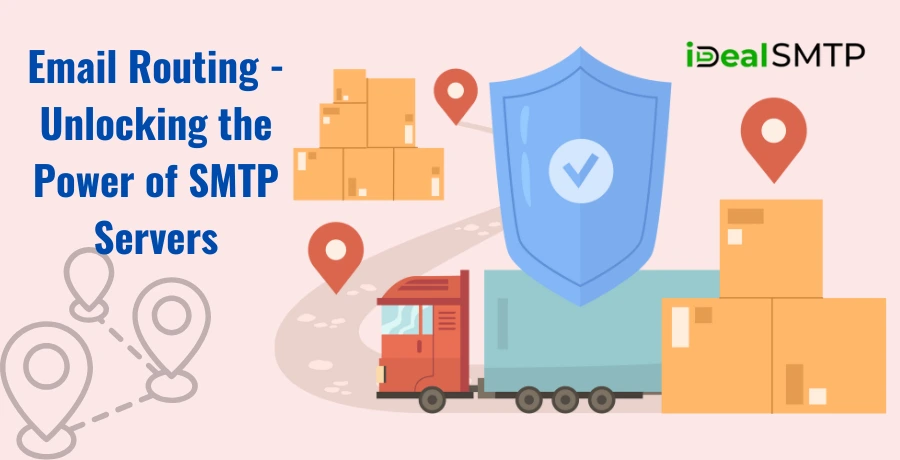On any given day, business emailing is the most common form of communication with stakeholders. However, few organizations understand the significance of email routing and how a properly tuned Simple Mail Transfer Protocol (SMTP) server will enhance the overall outlook of business emails by increasing the rate of delivery, functionality, and security.

So, in this article, you will learn what email routing is, what is the role of the SMTP servers and how the proper use of email routing makes business communications smoother, more effective, and more secure.
Table of Contents
Pricing
| Trail Plan | Standard Plan | Premium Plan | Professional Plan |
| $50 | $145 | $185 | $225 |
| Sending Limit | Sending Limit | Sending Limit | Sending Limit |
| 1000 Emails/Hour | 1500 Emails/Hour | 3000 Emails/Hour | 5000 Emails/Hour |
What is Email Routing?
Email routing can be defined as the management and control of emails from a sender’s server to the recipient’s server through channels on the internet. This process has several steps so that messages can end up in the right inbox. In other words, each packet of e-mail message takes its route through the sender and gets safely delivered to its rightful owner.
Proper email routing can help eliminate some of the causes of those delays and keep bounce rates in check to enhance email deliverability. The technique of email routing is another key success factor for any company to ensure that its messages reach the customer’s inbox and do not end up in the spam or junk directory.
Understanding the Role of SMTP Servers in Email Routing
The SMTP server is the main system for the sending of outgoing messages. It therefore has a significant function for channeling the mail regarding direction on the networks. Here’s a quick breakdown of how it works:
- Initiating Connection: Whenever a sender hits the send button, the SMTP server checks the authenticity of the address of the sender and initiates the process of connection.
- Determining Pathways: Anyway, the server himself calculates how he has to deliver the message depending on the domain of the recipient’s E-mail address.
- Handing Off to Other Servers: In the case that the message is delivered beyond the scope of the sender’s server system, the message may travel through many intermediate SMTP hosts that collaborate to deliver the message to the destination.
- Confirmation and Tracking: When the message gets to the recipient’s server another report of delivery is sent to inform the sender that the message has been delivered.
This process occurs within a few seconds; however, it is possible only if routing protocols are used, and the SMTP server is correctly configured for greater stability and protection.
Benefits of Efficient Email Routing with SMTP Servers
Improved Deliverability: Non-spam emails are those correctly addressed so therefore they have a high likelihood to be delivered in primary folders. Correct email routing sets up security measures such as SPF, DKIM, and DMARC making the sender more believable.
Enhanced Security: To protect organizations’ emails, proper secure Email Relay pathways should be implemented and SMTP servers should be properly keyed up for authentication and encryption against undesired scams like Email spoofing and phishing.
Reduced Bounce Rates: Optimal routes to new users aid in preventing the delivery of e-mail to non-existent and in-active e-mail addresses hence reducing bounce rates. To ensure the validity of an email address, the sender’s SMTP servers commonly verify with recipient servers thereby preserving sender’s reputation.
Faster Delivery Times: There are many advantages of routing messages through SMTP servers with the importance on the fact that e-mail messages get to the intended recipients on time – important for transactional and time-sensitive e-mails.
Scalability for High-Volume Sends: Some of the benefits of efficient routing include; A business that deals with the large sending of emails, promotional emails newsletters is an advantage by efficient routing. It ensures high delivery rates especially when sending out a large number of emails which is very important for companies to grow their email marketing.
Key Steps for Optimizing Email Routing with SMTP
Set Up Multiple SMTP Relays: The use of multiple SMTP relays comes in handy in equal distribution of load, especially during a send operation. It also offers backup or reserve means so that if one particular means fails, others are still there.

Implement Authentication Protocols: SPF (Sender Policy Framework), DKIM (DomainKeys Identified Mail) and DMARC (Domain-based Message Authentication, Reporting, and Conformance) help to increase credibility and deliver emails to the intended recipient’s inbox.
Use Smart Routing Technology: Today’s higher-level SMTP services feature smart routing, which means a particular message is dispatched in the fastest way possible, by choosing the optimal path considering such criteria as server location or load, for instance, does not contribute to latency and improves delivery.
Optimize IP Warmup Procedures: Finally, for new IPs, it is important to limit the number of emails that are being sent, a process called IP warming, and increase it systematically. It establishes the sender’s credentials with internet service providers (ISPs) while ensuring that the corresponding emails do not end up in the spam folder.
Monitor and Analyze Bounce Rates and Delivery Reports: A few of the following measures should be taken on a daily/weekly basis, to manage to identify routing problems at an early stage: Almost every SMTP provider provides a statistic of email delivery, which enables the user to correct mistakes or fine-tune the process.
Choosing the Right SMTP Provider for Email Routing
This means that not all SMTP providers are created equal bearing in mind the case of email routing. Some providers may be much better at building solid routing, which will contribute to enhanced deliverability and reliability. When evaluating SMTP providers, consider the following:
- Reliability and Uptime: Choose solution providers who boast of high uptimes so that your emails will be forwarded at every time.
- Security Features: Security in the providers is well realized by having measures against potential dangers such as spoofing and phishing.
- Smart Routing Options: Mailers who use AI for routing or if they link to multiple servers can enhance the overall delivery rate while minimizing congestion.
- Detailed Analytics and Reporting: Especially, using real-time data concerning email performance is essential to maintain the optimization continuously.
Advanced Strategies for Managing Email Routing
To maximize the effectiveness of email routing, businesses can employ more advanced techniques that help manage the volume, prioritize messages, and adapt to different types of email communication:

Business Prioritization Dynamic Routing
Not all emails have the same level of implication or the need for immediate response or action as well. It is such routing techniques in businesses that enable crucial and time-sensitive emails to run in dedicated and low latency SMTP servers, unlike newsletters that can run on secondary servers. This emphasis reduces the chance of time-critical messages, for instance, security threats or customers’ concerns, to reach the intended recipients late.
International Requirement for Geo-Based Routing
In global operations, the deliverability of emails can be increased and customer satisfaction can be provided by routing the emails geographically. Geo-based routing is an effective way of routing messages through known SMTP servers in the vicinity of the recipient and in compliance with his or her region’s rules. It also enables users to overcome such limitations that might be exercised by the ISPs and may vary from country to country.
Load Balancing Concerning High-Volume Sends
That is why, during immense marketing campaigns like holidays or any product promotion, it is highly advisable to distribute a load of emails to be sent. It helps distribute the incoming and outgoing email traffic abundantly on the multiple SMTP servers to avoid congestion of a single server. It is useful in ensuring servers do not derail, or freeze when conducting a large send, which is essential when conducting numerous targeted sends.
Failover Routing for Redundancy and Resilience
Also, failover routing adds some time of security in email routing. In case a first ISA server experiences problems or is offline, fail-over routing instantaneously swaps the path of the e-mail to the backup servers to guarantee the continuity of the message. Such an arrangement is vital for most of the triggering emails and other business-related email messages that cannot wait.
Optimized Throttling and Burst Sending
To avoid top outgoing sends being signaled by ISPs as spam, there is the option of regulating email delivery. Throttling refers to controlling the number of emails to be delivered in an hour while burst sending allows certain pre-authorized emails to be sent out at any time. This interplay between send rates and priority helps to keep the sender’s reputation good and avoid a lot of emails being blocked.
Real-Time Monitoring and A/B Testing for Routing Effectiveness
Using actual reported feedback tools, managers can measure how well the email routing performs by evaluating the bounce rate, the delivery speed, and many more. SMTP paths can be fine-tuned in the same way, as A/B testing can be used to find out which configuration provides the highest deliverability rates. The information obtainable makes it possible to make alterations to routing protocols to continuously improve these.
Conclusion
Due to growing sophisticated types of email technologies, new and improved solutions of smart email routing are helping business organizations to realize faster, more secure, and more reliable communication. With a world domination of hundreds of millions of users and billions of messages being sent daily, knowledge of SMTP servers and their role in the outgoing and incoming messages can help companies make the right decision in choosing its communications medium or channel of the business message among the overwhelming number of messages reaching the in-boxes daily.
Costing some amount of money in routing the emails through SMTP sever enhances the way of communication with customers apart from enhancing the reputation of the specific brand.







